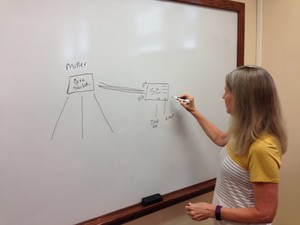Burk sees IoT, VR in CSC's future

CHADRON – When Ann Burk started her career as a Computer Operator for Chadron State College she worked with punch cards and main frame computers. A few years later, she was part of a networking team that initiated the college’s first internet connection through a state modem pool.
Fast forward to today’s quickly changing information technology world, and Burk, now Chief Information Officer at CSC, can visualize many new developments coming to computing and networking on campus, including more cloud computing, virtual reality (VR) and implementation of the technology called the Internet of Things (IoT).
Before those futuristic developments can happen, however, CSC’s Information Technology department has to make sure there is adequate infrastructure to securely handle huge volumes of digital data, and that requires constant effort.
“We are continually upgrading,” Burk said.
The first legs of IT infrastructure, fiber optic cable connections to the internet and into campus buildings, are already in place. The college has two separate fiber optic connections that follow different routes across the state, each connecting to the internet, which provide redundancy in case one is disrupted, Burk said. Fiber optic cables also connect all campus buildings to the data center in Miller Hall.
“I think we have all the fiber we need,” said Burk, an advocate of physical connections for all critical functions.
An upgrade currently keeping the IT team busy involves replacing older switches that supply network connections in campus buildings.
“We have two, 10 gigabyte fiber connections to each building. They connect to two switches so that if one goes down, the other can take over,” Burk said.
The new switches, which have already been installed in residence halls, the Student Center, Crites Hall, and Miller Hall, and are incorporated in all new construction, will improve network speeds and bring fast reliable service to wired connections and to the wireless infrastructure, Burk said.
Connection speeds that previously topped out at 100 megabytes will now be able to reach one gigabyte, according to Burk. That in turn will allow faster speeds through the wireless access points that deliver internet connections to mobile devices like cell phones and tablet computers.
Departments such as CSC Facilities are beginning to adopt the Internet of Things, said Burk. With IoT, a cellphone or other internet connected device can be used to monitor and control smart appliances. The technology has been implemented for controlling lights in Sparks Hall and will likely be used in other buildings, Burk said.
Another technology Burk expects to expand at CSC is cloud based computing, the use of software hosted on internet provisioned versus on campus servers. The technology isn’t new on campus, where cloud applications like the Office 365 software suite and the Sakai learning management system are already well established, but will be used even more in the future, she said.
“Services will continue to move to the cloud,” she said. “If a certain service is desired, we look to cloud-based services first.”
That has benefits in terms of cost, data center footprint, and staffing.
“(With cloud computing) our staff can focus on helping the users rather than keeping servers up and running within our data center,” Burk said. “That already works well for us.”
One new web-based service currently being tested for classroom use is Zoom, a teleconferencing application which could replace the older video-conferencing equipment that has been part of CSC’s distance learning centers for several years. Zoom has been used for administrative meetings for more than a year, and has recently been extended to academic use.
“As faculty develop expertise, the students previously going to classrooms in North Platte or Scottsbluff will be able to attend from their internet connected home,” she said. “That’s advantageous for students who may live several miles away from our distance learning classroom locations.”
Virtual Reality, the technology that gives users a realistic three-dimensional experience of a particular place or thing, is also being tested at CSC, and brings exciting prospects for enhanced learning, said Burk.
“Virtual Reality has been piloted on campus for the past year and development is moving forward,” she said.
Potential uses include allowing anatomy students to observe directly how the body functions.
“It enables you to explore the body, to watch the heartbeat, to observe normal and abnormal functions,” Burk said.
Incorporating VR into classroom activities and assignments will enhance students’ active learning, according to Burk.
“Once faculty see the impact of this active learning technology and students get really excited about it, VRwill become a popular academic tool in many different disciplines,” she said.
Though not currently under development, facial recognition technology could also come to CSC in the future, according to Burk. Students currently use their ID cards to access residence halls and for other services, but that could change, according to Burk.
“I imagine we’ll get to a point where they will be scanning retinas or using facial recognition for identity (verification),” she said.
While the possibilities opened by new technology are almost endless, concern for security remains a top priority for Burk and her staff.
“One of our primary responsibilities is to insure protection of data, whether that is applied to applications, to the desktop environment or to the network servers,” she said. “That’s always one of the first things we look at when we are implementing changes and balancing security with meeting the needs of faculty and students is a challenge.”
To assist with meeting compliance requirements and develop mechanisms to guard against and respond to security incidents, CSC and the other colleges in the Nebraska State College System are collaborating to create a Virtual Chief Information Security Officer position, said Burk.
“We are trying to be very intentional about insuring we have a common plans in place,” she said. “Prevention is the priority via sound policies and procedures. Likewise, you have to have plans in place, in case you have to quickly react.”
Category: Campus News, Information Technology
